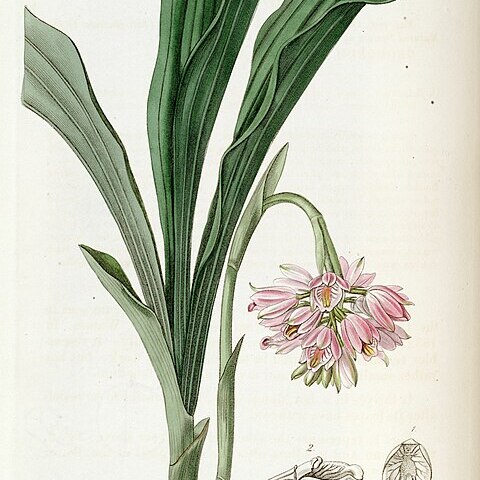Herbs, terrestrial, medium-sized, leafy. Pseudobulbs subterranean, cormlike or tuberous, usually globose, few noded, borne on a short rhizome and usually forming clusters, with several thick roots at nodes. Leaves arising from basal node of pseudobulb, several, uppermost largest, contracted into a long petiole-like stalk at base, plicate; petiole-like stalk usually equitant and forming a pseudostem, articulate. Inflorescence arising from basal node of pseudobulb, terminal, racemose; peduncle erect at base, curved through 180° and drooping toward apex; rachis pendulous but becoming erect in fruit, short, usually densely several to many flowered and appearing capitate. Flowers medium-sized or small, not opening widely, not resupinate but, because peduncle pendulous at apex, lip positioned lowermost. Sepals and petals similar though petals usually slightly broader, free, not spreading; lip unlobed or obscurely 3-lobed, base usually saccate, without a distinct spur; disk usually with a callus composed of ridges or wartlike projections. Column short, with a short column foot; anther terminal, 1-locular or incompletely 2-locular, with cap; pollinia 2, usually cleft, waxy, attached to a broad stipe and a large viscidium.
More
Deciduous, terrestrial orchids with tough pseudobulbs in a row held close to the soil surface and supported by coarse, spreading roots. Leaves several per pseudobulb, petiolate, bases communally enclosed in sheathing bracts, blades broad, plicate. Inflorescence racemose, arising in axil of bract on developing shoot, nodding conspicuously when in bud and flower, straightening as capsules develop prior to seed dispersal. Flowers more or less tubular to bell-shaped. Sepals and petals free, similar in shape and size, not spreading widely. Labellum attached to base of column and column foot, forming a concave, pouch-like structure. Labellum lamina 3-lobed, without basal spur. Column with column foot.

